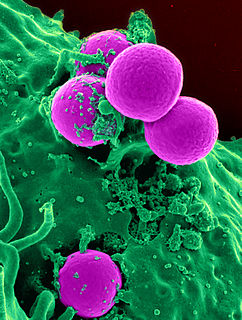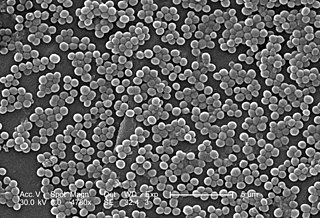
Staphylococcus aureus is a Gram-positive, round-shaped bacterium that is a member of the Firmicutes, and it is a usual member of the microbiota of the body, frequently found in the upper respiratory tract and on the skin. It is often positive for catalase and nitrate reduction and is a facultative anaerobe that can grow without the need for oxygen. Although S. aureus usually acts as a commensal of the human microbiota it can also become an opportunistic pathogen, being a common cause of skin infections including abscesses, respiratory infections such as sinusitis, and food poisoning. Pathogenic strains often promote infections by producing virulence factors such as potent protein toxins, and the expression of a cell-surface protein that binds and inactivates antibodies. The emergence of antibiotic-resistant strains of S. aureus such as methicillin-resistant S. aureus (MRSA) is a worldwide problem in clinical medicine. Despite much research and development, no vaccine for S. aureus has been approved.

Methicillin-resistant Staphylococcus aureus (MRSA) refers to a group of Gram-positive bacteria that are genetically distinct from other strains of Staphylococcus aureus. MRSA is responsible for several difficult-to-treat infections in humans. MRSA is any strain of S. aureus that has developed, through horizontal gene transfer and natural selection, multiple drug resistance to beta-lactam antibiotics. β-lactam antibiotics are a broad-spectrum group that include some penams and cephems such as the cephalosporins. Strains unable to resist these antibiotics are classified as methicillin-susceptible S. aureus, or MSSA.

Methicillin, also known as meticillin, is a narrow-spectrum β-lactam antibiotic of the penicillin class.

Vancomycin-resistant Staphylococcus aureus are strains of Staphylococcus aureus that have become resistant to the glycopeptide antibiotic vancomycin.
Glycopeptide antibiotics are a class of drugs of microbial origin that are composed of glycosylated cyclic or polycyclic nonribosomal peptides. Significant glycopeptide antibiotics include the anti-infective antibiotics vancomycin, teicoplanin, telavancin, ramoplanin and decaplanin, corbomycin, complestatin and the antitumor antibiotic bleomycin. Vancomycin is used if infection with methicillin-resistant Staphylococcus aureus (MRSA) is suspected.

Flucloxacillin, also known as floxacillin, is a narrow-spectrum beta-lactam antibiotic of the penicillin class. It is used to treat infections caused by susceptible Gram-positive bacteria. Unlike other penicillins, flucloxacillin has activity against beta-lactamase-producing organisms such as Staphylococcus aureus as it is beta-lactamase stable. However, it is ineffective against methicillin-resistant Staphylococcus aureus (MRSA). It is very similar to dicloxacillin; they are considered interchangeable.

Pristinamycin (INN), also spelled pristinamycine, is an antibiotic used primarily in the treatment of staphylococcal infections, and to a lesser extent streptococcal infections. It is a streptogramin group antibiotic, similar to virginiamycin, derived from the bacterium Streptomyces pristinaespiralis. It is marketed in Europe by Sanofi-Aventis under the trade name Pyostacine.

Dicloxacillin is a narrow-spectrum β-lactam antibiotic of the penicillin class. It is used to treat infections caused by susceptible (non-resistant) Gram-positive bacteria. It is active against beta-lactamase-producing organisms such as Staphylococcus aureus, which would otherwise be resistant to most penicillins. Dicloxacillin is available under a variety of trade names including Diclocil (BMS).
An emerging infectious disease (EID) is an infectious disease whose incidence has increased in the past 20 years and could increase in the near future. Emerging infections account for at least 12% of all human pathogens. EIDs are caused by newly identified species or strains that may have evolved from a known infection or spread to a new population or to an area undergoing ecologic transformation, or be reemerging infections, like drug resistant tuberculosis. Nosocomial (hospital-acquired) infections, such as methicillin-resistant Staphylococcus aureus are emerging in hospitals, and extremely problematic in that they are resistant to many antibiotics. Of growing concern are adverse synergistic interactions between emerging diseases and other infectious and non-infectious conditions leading to the development of novel syndemics. Many emerging diseases are zoonotic - an animal reservoir incubates the organism, with only occasional transmission into human populations.

Oxacillin is a narrow-spectrum beta-lactam antibiotic of the penicillin class developed by Beecham.

Panton–Valentine leukocidin (PVL) is a cytotoxin—one of the β-pore-forming toxins. The presence of PVL is associated with increased virulence of certain strains (isolates) of Staphylococcus aureus. It is present in the majority of community-associated Methicillin-resistant Staphylococcus aureus (CA-MRSA) isolates studied and is the cause of necrotic lesions involving the skin or mucosa, including necrotic hemorrhagic pneumonia. PVL creates pores in the membranes of infected cells. PVL is produced from the genetic material of a bacteriophage that infects Staphylococcus aureus, making it more virulent.

{{Drugbox | Verifiedfields = changed | Watchedfields = changed | verifiedrevid = 385028149 | IUPAC_name = 2-deoxy-1-O-[(3S,15R,18R,34R,35S,38S,48R,50aR)-5,31-dichloro-38-{[3-(dimethylamino)propyl]carbamoyl}-6,11,34,40,44-pentahydroxy-42-(α-D-mannopyranosyloxy)-15-(methylamino)-2,16,36,50,51,59-hexaoxo-2,3,16,17,18,19,35,36,37,38,48,49,50,50a-tetradecahydro-1H,15H,34H-20,23:30,33-dietheno-3,18:35,48-bis(iminomethano) 4,8:10,14:25,28:43,47-tetrametheno[1,14,6,22]dioxadiazacyclooctacosino[4,5-m][10,2,16]benzoxadiazacyclotetracosin-56-yl]-2-[(10-methylundecanoyl)amino]-β-D-glucopyranuronic acid | image = Dalbavancin_B0.svg | tradename = Dalvance, Xydalba | pregnancy_AU = | pregnancy_US = | pregnancy_category = | licence_EU = yes | legal_AU = | legal_CA = | legal_UK = | legal_US = | legal_status = | routes_of_administration = Intravenous | bioavailability = | protein_bound = | metabolism = | elimination_half-life = | excretion = | CAS_number_Ref = | CAS_number = 171500-79-1 | ATC_prefix = J01 | ATC_suffix = XA04 | PubChem = 16134410 | DrugBank_Ref = | DrugBank = | UNII_Ref = | UNII = 808UI9MS5K | ChEBI_Ref = | ChEBI = 82721 | ChEMBL_Ref = | ChEMBL = 527063 | ChemSpiderID_Ref = | ChemSpiderID = 23340937 | smiles = CC(C)CCCCCCCCC(=O)N[C@@H]1[C@H]([C@@H] O)O | StdInChI_Ref = | StdInChI = 1S/C88H100Cl2N10O28/c1-38(2)13-10-8-6-7-9-11-14-61(106)94-70-73(109)75(111)78(86 121)128-87(70)127-77-58-31-43-32-59(77)124-55-23-19-42(29-50 89)71(107)69-85(119)98-67(80 92-25-12-26-100 5)48-33-44(102)34-57(125-88-76 74 72 60 126-88)62(48)47-28-40(17-22-52 103)65(82 99-69)95-83(117)66(43)96-84(118)68-49-35-46(36-54 63 90)123-56-24-18-41(30-53 104)64(91-3)81(115)93-51(79 97-68)27-39-15-20-45(122-58)21-16-39/h15-24,28-36,38,51,60,64-76,78,87-88,91,101-105,107-112H,6-14,25-27,37H2,1-5H3,(H,92,114)(H,93,115)(H,94,106)(H,95,117)(H,96,118)(H,97,113)(H,98,119)(H,99,116)(H,120,121)/t51-,60-,64-,65-,66-,67+,68+,69+,70-,71-,72-,73-,74+,75+,76+,78+,87-,88+/m1/s1 | StdInChIKey_Ref = | StdInChIKey = IZJRUXNZMRDQJI-SZUNQUCBSA-N | C=88 | H=100 | Cl=2 | N=10 | O=28 | molecular_weight = 1816.7 g/mol }}

ST8:USA300 is a strain of community-associated methicillin-resistant Staphylococcus aureus (MRSA) that has emerged as a particularly antibiotic resistant epidemic that is responsible for rapidly progressive, fatal diseases including necrotizing pneumonia, severe sepsis and necrotizing fasciitis. The epidemiology of infections caused by MRSA is rapidly changing: in the past 10 years, infections caused by this organism have emerged in the community. The 2 MRSA clones in the United States most closely associated with community outbreaks, USA400 and USA300, often contain Panton-Valentine leukocidin (PVL) genes and, more frequently, have been associated with skin and soft tissue infections. Outbreaks of community-associated (CA)-MRSA infections have been reported in correctional facilities, among athletic teams, among military recruits, in newborn nurseries, and among sexually active homosexual men. CA-MRSA infections now appear to be endemic in many urban regions and cause most MRSA infections.

A staphylococcus infection or staph infection is an infection caused by members of the Staphylococcus genus of bacteria. These bacteria commonly inhabit the skin and nose where they are innocuous, but may enter the body through cuts or abrasions which may be nearly invisible. Once inside the body, the bacterium may spread to a number of body systems and organs, including the heart, where the toxins produced by the bacterium may cause cardiac arrest. Once the bacterium has been identified as the cause of the illness, treatment is often in the form of antibiotics and, where possible, drainage of the infected area. However, many strains of this bacterium have become antibiotic resistant; for those suffering these kinds of infection, the body's own immune system is the only defense against the disease. If that system is weakened or compromised, the disease may progress rapidly. Anyone can contract Staph; but, pregnant women, children, people with chronic diseases or are immune-deficient are often more susceptible to contracting an infection.
The mecA gene is a gene found in bacterial cells which allows a bacterium to be resistant to antibiotics such as methicillin, penicillin and other penicillin-like antibiotics.

Arbekacin (INN) is a semisynthetic aminoglycoside antibiotic. It is primarily used for the treatment of infections caused by multi-resistant bacteria including methicillin-resistant Staphylococcus aureus (MRSA). Arbekacin was originally synthesized from dibekacin in 1973. It has been registered and marketed in Japan since 1990 under the trade name Habekacin. Arbekacin is no longer covered by patent and generic versions of the drug are also available under such trade names as Decontasin and Blubatosine.

Sophoraflavanone G is a volatile phytoncide, released into the atmosphere, soil and ground water, by members of the Sophora genus. Due to an increase in the rates of antibiotic-resistant bacteria, scientific efforts have focused on finding either naturally-made or genetically modified compounds that can treat and or prevent these harmful and sometimes deadly bacteria. Sophoraflavanone G, due to its use as a phytoncide, has been found to impact the growth of antibiotic-resistant bacteria and enhance the effect of currently used antibiotics.
Pseudoalteromonas phenolica is a marine bacterium species in the genus Pseudoalteromonas.

Anthracimycin is a polyketide antibiotic discovered in 2013. Anthracimycin is derived from marine actinobacteria. In preliminary laboratory research, it has shown activity against Bacillus anthracis, the bacteria that causes anthrax, and against methicillin-resistant Staphylococcus aureus (MRSA).
The arginine catabolic mobile element (ACME) is a mobile genetic element of Staphylococcus bacterial species. This genetic element provides for several immune modulating functions, including resistance to polyamines which serve as a non-specific immune response both on intact skin and following the inflammatory response in wound healing. Diverse ACME are present in several species of Staphylococcus, including Staphylococcus epidermidis.














